
The Physciaceae are a family of mostly lichen-forming fungi belonging to the class Lecanoromycetes in the division Ascomycota. A 2016 estimate placed 19 genera and 601 species in the family.
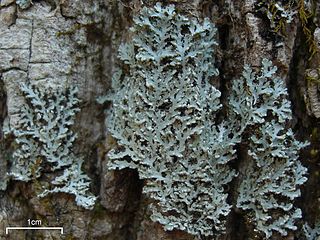
Heterodermia is a genus of lichenized fungi in the family Physciaceae. The genus has a widespread distribution, especially in tropical regions, and contains about 80 species.
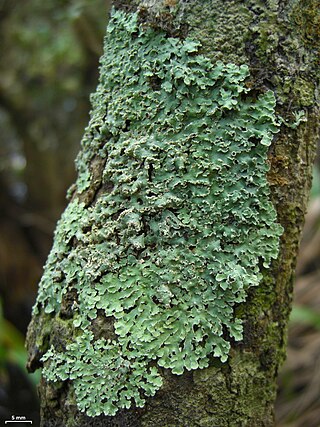
Physcia is a genus of lichen-forming fungi in the family Physciaceae. The widely distributed genus contains about 80 species. The genus is cosmopolitan, and has been extensively studied in various regions in the past several decades, with significant biodiversity in South America identified as a central diversity hotspot. Physcia species are foliose, lobate lichens that grow with a loose to close appressed habit. Their upper surface is typically whitish, pale greenish, green-grey, or dark grey in colour. The thallus colour remains relatively unchanged when moistened. Physcia lichens typically grow on bark, on wood, or rock, although they have occasionally been recorded dwelling on man-made structures. They thrive in nutrient-rich environments and are expanding rapidly in urban areas of the United Kingdom previously affected by SO2 pollution.

Phaeophyscia is a genus of lichen-forming fungi in the family Physciaceae.
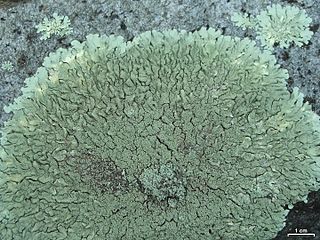
Xanthoparmelia is a genus of foliose lichens in the family Parmeliaceae. This genus of lichen is commonly found in the United States, as well as Australia, New Zealand and Ecuador.
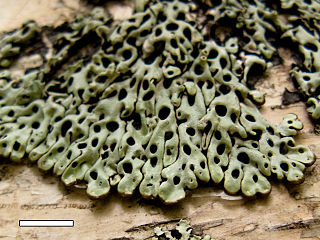
Menegazzia is a genus of lichenized fungi containing roughly 70 accepted species. The group is sometimes referred to as the tree flutes, honeycombed lichens, or hole-punch lichens. The most obvious morphological feature of the genus is the distinctive perforations spread across the upper side of the thallus. This makes the group easy to recognise, even for those not particularly familiar with lichen identification.

Punctelia hypoleucites, commonly known as the southwestern speckled shield lichen, is a species of foliose (leafy) lichen in the family Parmeliaceae. First formally described by Finnish botanist William Nylander as a species of Parmelia, it was transferred to the genus Punctelia in 1982. The lichen is found in Africa, North America, and South America, where it grows on the bark of both hardwood and coniferous trees. Its greenish-grey thallus is covered with tiny white pseudocyphellae – minute holes in the thallus surface that facilitate gas exchange. Some macroscopic features that help distinguish this species from other related members of the genus include the presence and the structure of the apothecia, the absence of asexual surface propagules, and the light brown color of the thallus undersurface. Chemically, the presence of lecanoric acid in the medulla and atranorin in the cortex help distinguish it from lookalikes.
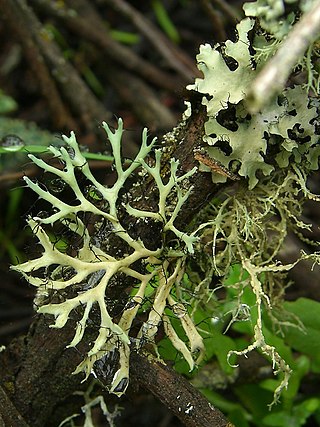
Leucodermia is a genus of lichen-forming fungi in the family Physciaceae.
Apatoplaca is a fungal genus in the family Teloschistaceae. It is monotypic, containing a single species, the rare crustose lichen Apatoplaca oblongula, found in the United States.
Physconia rossica is a species of saxicolous (rock-dwelling), foliose lichen in the family Physciaceae. It is found in mountainous regions of the Russian Far East, Siberia, and Eastern Europe.

Solorina crocea, commonly known as the orange chocolate chip lichen, is a species of terricolous (ground-dwelling) and foliose (leafy) lichen in the family Peltigeraceae. The lichen, which was first formally described by Carl Linnaeus in 1753, has an arctic–alpine and circumpolar distribution and occurs in Asia, Europe, North America, and New Zealand. It generally grows on the bare ground in sandy soils, often in moist soil near snow patches or seepage areas. Although several forms and varieties of the lichen have been proposed in its history, these are not considered to have any independent taxonomic significance.
Opeltiella is a genus of lichen-forming fungi in the family Candelariaceae. The genus, established by Sergey Kondratyuk in 2020, has four species. It is differentiated from the similar genus Candelaria by its unique features such as eight-spored asci and absence of a lower cortical layer and true rhizines. The genus is characterised by its areolate to more or less squamulose or foliose thallus and the unique chemical substances it contains, such as calycin, pulvinic and vulpinic acids, and pulvinic acid lactone.
Protothelenella is a genus of fungi in the family Protothelenellaceae. It contains 11 species, some of which form lichens. Protothelenella species have a crustose thallus with spherical to pear-shaped, dark brown to blackish perithecia. Microscopic characteristics of the genus include bitunicate asci with an amyloid tholus, and ascospores that are colourless and contain multiple internal partitions. Some species grow on acidic substrates including rocks, soil, bryophytes, plant detritus or rotten wood. Other species are lichenicolous (lichen-dwelling), growing on species of Solorina, Peltigera, Pseudocyphellaria, or Cladonia.
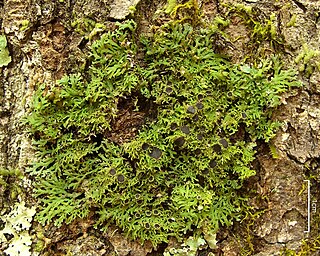
Kurokawia is a genus of lichen-forming fungi in the family Physciaceae. It has seven species of foliose lichens. The genus, circumscribed in 2021, has Kurokawia isidiata as the type species.

Anaptychia ciliaris, commonly known as the great ciliated lichen or eagle's claws, is a species of fruticose lichen in the family Physciaceae. It is predominantly found in Northern Europe, with its range extending to European Russia, the Caucasus, Central and Southern Europe, the Canary Islands, and parts of Asia. First mentioned in botanical literature by the Italian botanist Fabio Colonna in 1606, the species was formally described by Carl Linnaeus in 1753, who highlighted its unique physical characteristics such as its grey colour, its unusual leafy form with linear fringe-like segments, and the presence of hair-like structures. This lichen is adaptable in its choice of substrates, mostly growing on tree barks and less commonly on rocks.
Anaptychia ethiopica is a species of lichen in the family Teloschistaceae. Found in East Africa, China, and Russia, it was formally described as a new species in 1976 by lichenologists Thomas Douglas Victor Swinscow and Hildur Krog. The type specimen was collected from Mount Bwahit, where it was found growing on moss.

Kurokawia palmulata, the shaggy fringe lichen, is a species of corticolous (bark-dwelling), foliose lichen in the family Physciaceae.

Physciella chloantha is a species of foliose lichen in the family Physciaceae. The lichen, which occurs in diverse regions including the Upper Midwest of the US, Europe, Japan, Pakistan, and European Russia, is common in certain areas. Its thallus forms circular patches up to 3 cm in diameter, made up of many small, discrete lobes that can grow together to cover large areas, often intermingling with other lichen species. These lobes, which vary from short and rounded to slightly elongated, have numerous soralia on their edges and surfaces, while the undersides are white to pale tan with sparse rhizines. Apothecia are uncommon in this species. Physciella chloantha is known to grow on bark and on rocks.
Awasthia is a monotypic fungal genus in the family Physciaceae. It contains the single species Awasthia melanotricha, a foliose lichen found in the Nepal Himalayas.












